Different Uses For Eggs Around The World
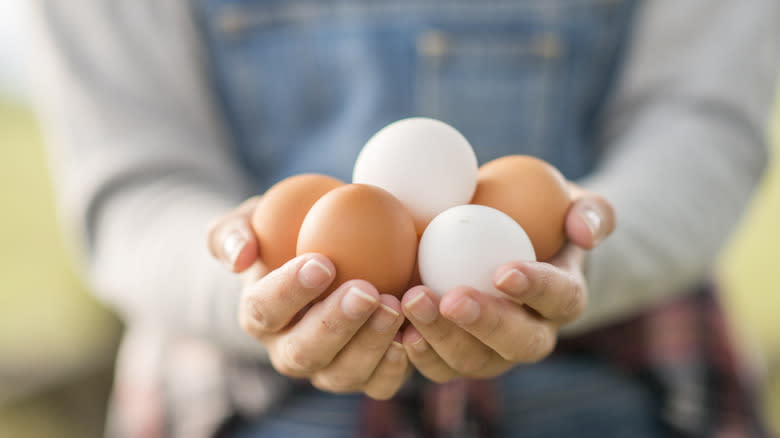
Eggs are one of the most commonly eaten foods in the world. Americans consumed about 281 per person in 2023, equating to more than five per week according to Statista, a number that still pales in comparison to China, where people consume an average of 400 per year (per Insider Monkey). Whether you're baking a cake, making a meringue, or looking for a well-rounded breakfast, they fit the bill. And with their impressive nutritional profile and relatively low price point, it's no wonder people call them "the perfect protein."
One of the reasons eggs are so popular is that they are one of the most versatile ingredients out there. In the U.S., we scramble and poach them, turn them into sweet custards and velvety ice creams, and use them in a wide variety of baked goods. Across the globe, there is even more diversity in how this miraculous ingredient is used, from boozy drinks to delicate desserts. They even have some nonculinary uses. If you want to discover just how useful this refrigerator staple can be, keep reading, because we've rounded up 14 notable uses for eggs from around the world.
Read more: 15 Mistakes Everyone Makes When Cooking Eggs
Kogel Mogel (Poland)
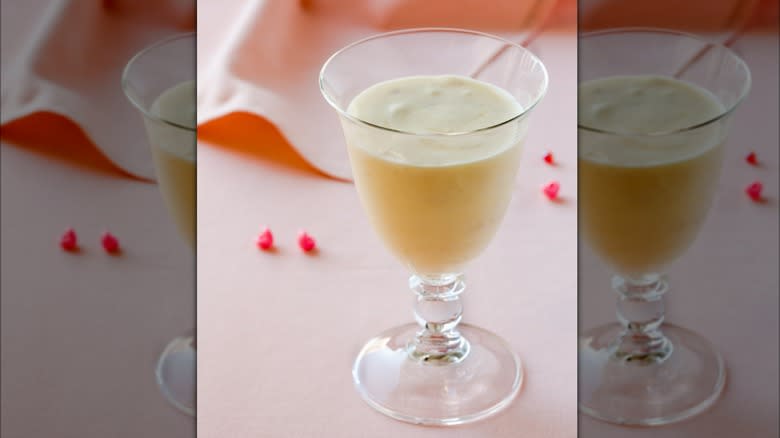
For many Americans, chicken soup is the first line of defense against a cold. But in Eastern Europe, especially Poland, a sweet, egg-based drink has historically been the cure of choice. Kogel mogel (also called gogl-mogl and גאָגל-מאָגל) is similar to eggnog but is often served hot and has fewer ingredients. Some recipes only call for two of them: egg yolks and sugar. Other variations are less decadent, calling for the sugar and eggs to be beaten into hot milk, while some go all-in on the richness, calling for the addition of chocolate, butter, and brandy.
Kogel mogel is a traditional remedy in Eastern European Jewish communities, who brought the drink to the U.S. Barbra Streisand's mother prescribed it to her after one of the singer's first major performances, and former New York City mayor Ed Koch had his own recipe that he described as being "far better than a doctor" for its "near-magical" effects on curing a cold. Even if you don't have a cold, however, this rich, velvety concoction is worth trying for its flavor and texture alone. Plus, if you like eggnog but can't quite bring yourself to drink it outside the holiday season, it's the perfect substitute.
Liu Sha Bao (China)
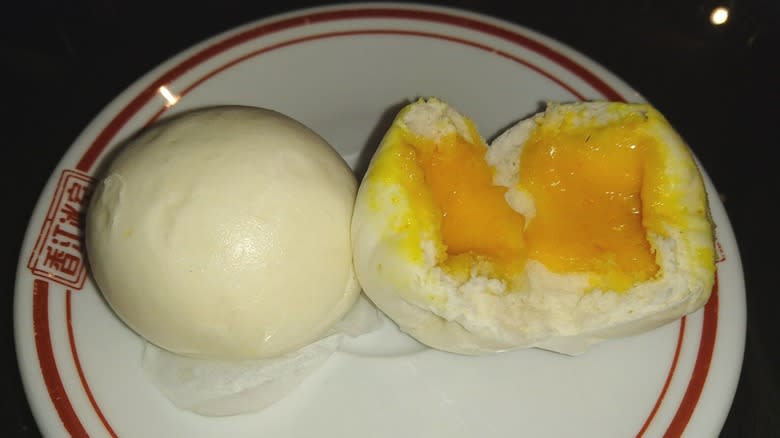
Fluffy, lightly sweet, and pillow-soft, bao buns are one of the most delicious foods in Chinese cuisine. Their springy, delicate texture is the result of steaming rather than baking, ensuring that there is no hard crust or overcooked chewiness. Bao come in many shapes, from ones that are pinched on top like dumplings, to ones that are shaped more like pillowy taco shells. They can be filled with many different ingredients, including pork and bean paste, but one of the most striking options is known as liu sha, molten salted custard made of egg yolks that makes for a deliciously textured dessert.
Custard egg bao look a little like soft-boiled eggs. Round, pale, and smooth on the outside, they reveal a runny yolk mixture in the center when they are pried open, giving them the literal translation "gold quicksand." There are many ways to make the filling. Some recipes use custard powder to keep the yolk from being too runny, while others add vanilla. The runny texture of the filling is not achieved by using raw egg yolks as one might assume, but by adding a liquid ingredient like evaporated milk or an ingredient that melts when heated, like butter, to fully cooked, mashed yolks. Most recipes call for duck eggs rather than chicken eggs, but if you're making them at home, the latter will suffice.
Egg Hoppers (Sri Lanka)
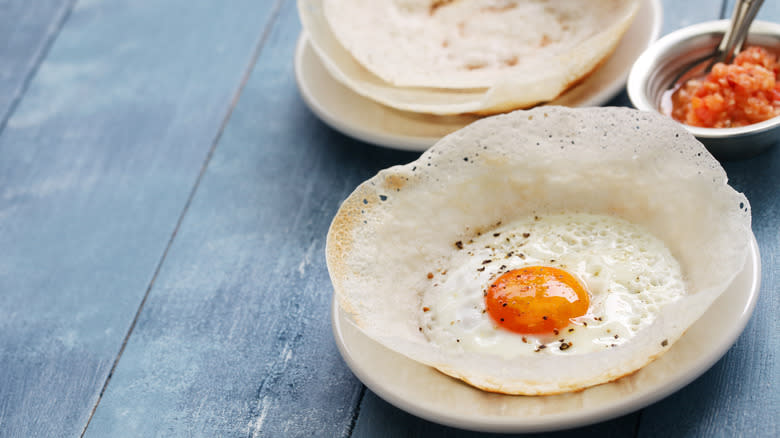
In Sri Lanka, you'll find one of the most visually arresting presentations of eggs: a paper-thin, lacy pancake shaped like a bowl with a sunny-side-up egg at the bottom. Called an egg hopper (after the pan that gives it a bowl-like shape), this dish is usually served for breakfast or as a street food. Unlike crepes and pancakes in the U.S., they are savory rather than sweet, and are most frequently served with spicy sambal, kiri hodi (a type of coconut sauce), and daal.
You need a hopper pan or small wok in order to create the classic bowl shape, but even if you do have one, it can take time to master the process. Although the pancake is wafer-thin, it achieves its lacy, crispy texture with yeast. If you use fast-action yeast, you don't have to let the batter sit before cooking it, but it must be left overnight if you're using regular yeast. Instead of wheat flour, rice flour is used, along with coconut milk, salt, and a hint of demerara sugar or jaggery. Once the batter has been spread around the sides of the pan, a raw egg is cracked into the center where it is left to cook until the pancake is crispy.
Nargisi Kofta (India)
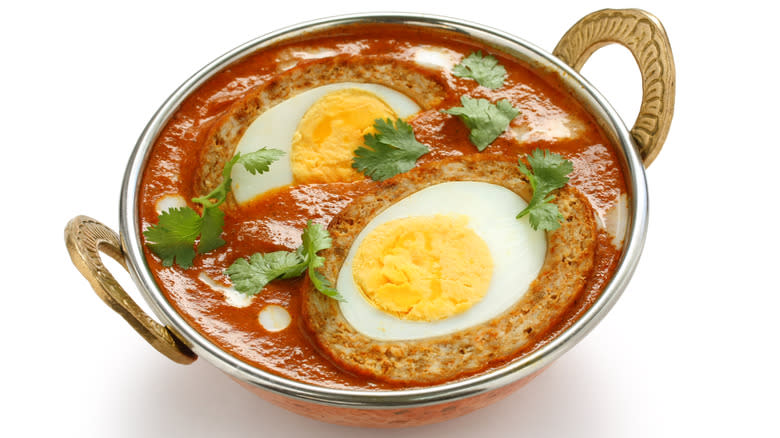
India eats relatively few eggs compared to other countries, averaging only 81 eggs per person each year compared to China's 400 (according to The Juggernaut). This is largely due to the country's large vegetarian population, comprised largely of Hindus, who are divided about whether eggs should be a part of the vegetarian diet: 31% of the population abstains from eating meat, and only 9% of that portion of the population eats eggs. But where eggs are a regular part of people's diets, the recipes are plentiful and mouthwatering.
One of the most delicious examples is nargisi kofta, a dish that hails from northern India and has its roots in the 16th century when the region was part of the Mughal Empire. It's made of hard-boiled eggs that are covered in a mixture of ground mutton and spices, coated in flour, and deep-fried. The eggs are then served in a spicy yogurt curry. Juicy, buttery, and fragrant with spices, it's a flavor-packed dish that ticks all the boxes. If you like Scotch eggs, nargisi kofta might become your new favorite food.
Ostrich Egg Lamps (South Africa)
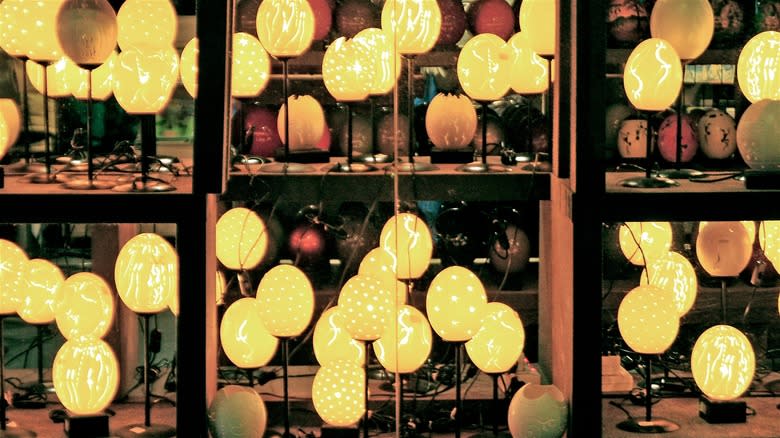
Ostrich eggs are significantly stronger and more durable than chicken eggs, weighing around three pounds (about as much as two dozen chicken eggs) and measuring about six inches in length. Given their thick, ceramic-like texture, artists in South Africa have been carving patterns and images into them for 60,000 years and continue to use them as canvases for their work. Nowadays, lamps are one of the most common products that feature ostrich egg art. Once the eggs have been carved with delicate patterns and pictures, a hole is made in one end to remove the eggy contents and insert a lightbulb. When the bulb is illuminated, the patterns cast shadows onto the wall.
In addition to being used for artistic purposes, ostrich eggs are used in other non-culinary ways. In the Kalahari Desert, for example, hunter-gatherers use them as vessels for water and as materials for making jewelry, in addition to eating them. If you happen to get your hands on one and want to cook with it, we've got everything you need to know about how ostrich eggs compare to chicken eggs.
Chawanmushi (Japan)
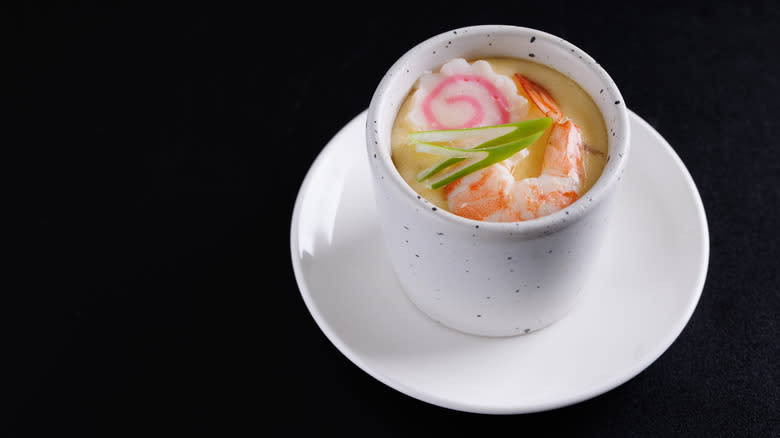
Custard is usually associated with dessert, but in Japanese cuisine, it's often savory. Take chawanmushi, for example. Translated to "teacup steamed egg custard," the silky mixture is made with eggs, dashi (an umami-rich broth), soy sauce, mirin, and sake, and presented in individual cups with chicken, shrimp, shiitake mushrooms, steamed fish cake, gingko nuts, and mitsuba (a variety of parsley). The dish was created in Nagasaki in the 18th century when trade with China led to a particular style of culinary fusion known as Shippoku banquet cuisine. These days it's beloved around the country for its powerful flavor and striking presentation.
Take a bite of this delicious appetizer and you might not even know it contains eggs. Creamy and smooth, it's a far cry from the thick custard you might order for dessert in the U.S. The secret to achieving this feather-light texture is using a high ratio of liquid to prevent the eggs from setting into something more akin to rubber.
Balut (Phillipines)
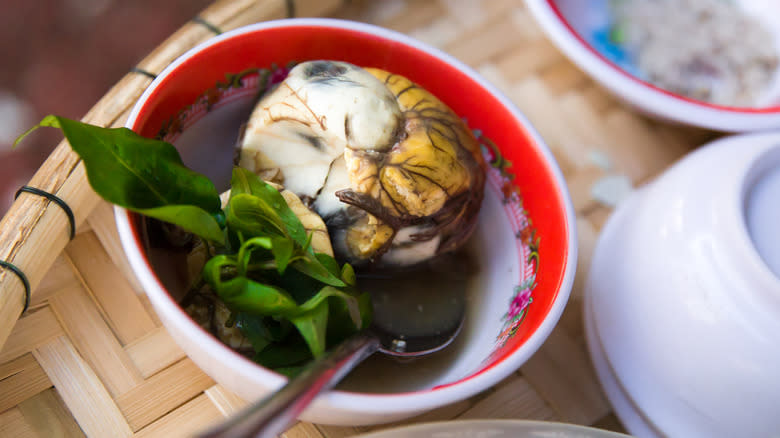
If you order a hardboiled egg from a restaurant in the U.S., you'll crack it open to find a thick, rubbery layer of egg white surrounding a firm, golden yolk. In the Philippines, a different type of hardboiled egg is the standard. Called balut, this street food is made by boiling a fertilized duck egg that has incubated for two to three weeks. Crack one open and you'll see a grayish-black duck embryo surrounding a golden yolk. Depending on how long the egg has incubated, you may even be able to detect eyes, a beak, and veins running through the yolk.
Eating partially incubated eggs began in China as a way to avoid wasting older eggs before modern refrigeration was created. Chinese traders brought the practice to the Philippines in the 16th century, where it became so popular that, although the dish is prevalent throughout Asia, it is commonly associated with the Philippines more than anywhere else. Balut is so popular in the country that it is the No. 1 product of the duck industry there, which produces about 45,000 metric tons of eggs per year.
Painting
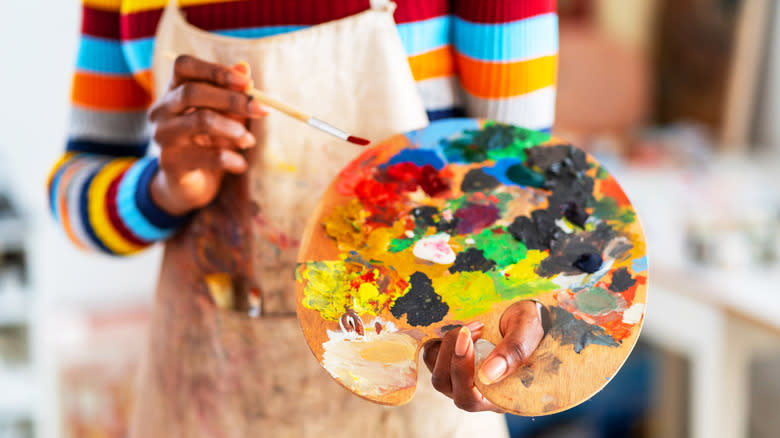
It turns out that one of the most beloved breakfast foods and quick sources of protein also happens to have special powers in the fine art world. Artists have been using eggs as a main ingredient in paint for thousands of years. In fact, it wasn't until the Renaissance in the late 15th century that it was replaced by oil as the medium of choice. All that was required to make egg-based paint, known as egg tempera, were egg yolks, water, and natural pigments.
Although oil became all the rage during the Renaissance, egg tempera is known for its durability, striking colors, and longevity, and its popularity has only grown over time as its staying power proves itself. While oil paintings from the Renaissance fade and crack, paintings made with egg tempera hundreds of years earlier look brand new. For this reason, it is still used widely for restoration purposes, even on oil paintings. When a painting has started to fade, egg tempera provides a seamless, long-lasting, and fast-drying solution.
Eierlikör (Germany)
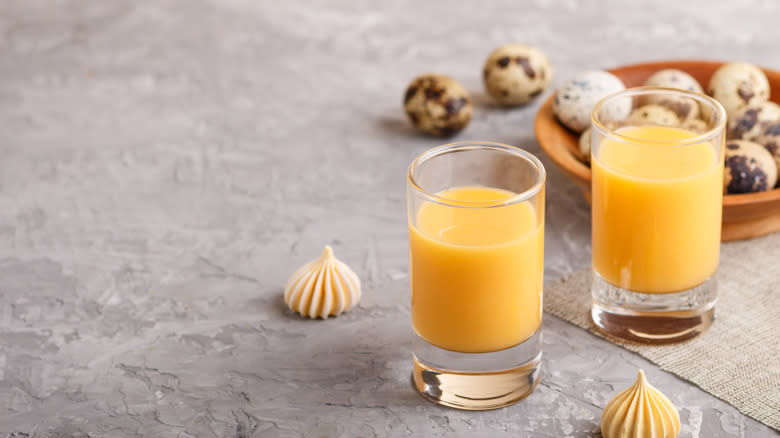
A quick rundown of the most popular alcoholic beverages proves that liquor can be made with just about anything. Vodka is made with potatoes, gin is made with grain and juniper berries, tequila is made with agave, and whiskey is made with corn, barley, rye, and wheat. Then there's the wide world of liqueurs, where things get even more diverse. There's the Spanish licor de bellota, which is made with acorns, for example, and any number of chocolate, fruit, and dairy-based options. It should be no surprise, therefore, that several countries make egg-based liqueurs. In Germany, the concoction is called eierlikör and is frequently made at home. Recipes usually call for a mixture of alcohol (rum, vodka, and brandy are popular), raw egg yolks, and sugar. Some also include vanilla, condensed milk, and cream. The resulting beverage has a much higher alcohol content than eggnog but has a similarly velvety texture and eggy flavor.
Although egg liqueur is beloved in Germany, Australia, and the Netherlands, it is based on a Brazilian drink called Abacate (Portuguese for "avocado") that was brewed in the Amazon. There it's made with rum, cane sugar, and avocados. When Dutch colonialists brought the recipe home to Europe in the 17th century, however, they used eggs to compensate for the avocado scarcity and called the drink "Advocaat." Although many German households make egg liqueur at home, Advocaat is available to buy around the world.
Egg Coffee (Vietnam)
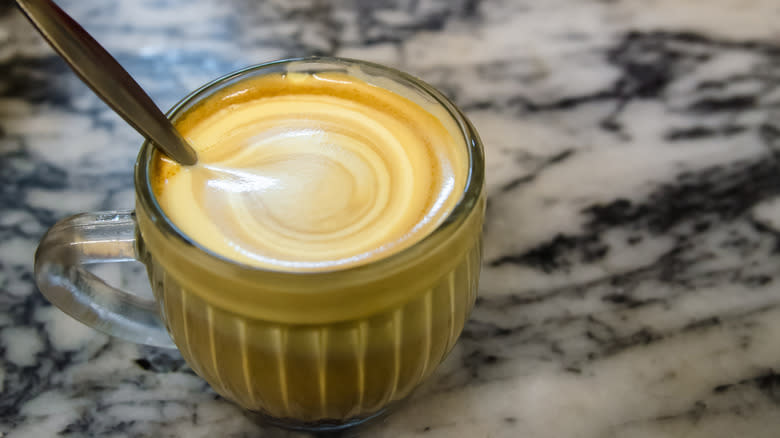
Anyone who luxuriates in a velvety cappuccino or enjoys a sugary frappuccino now and then will love Vietnamese egg coffee. It might not sound particularly appetizing, but one sip of this sweet, velvety beverage and you'll understand why it's been a beloved drink for decades. Made of coffee topped with a mixture of whipped egg yolk and sugar, it is frothy, sweet, and creamy. Many versions use condensed milk in addition to sugar, while others add butter for an even smoother consistency. Vanilla is also a popular addition, adding to the drink's dessert-like qualities.
If you order an egg coffee from a cafe in Hanoi these days or recreate the recipe at home, you'll probably be struck by the sheer decadence of the beverage. But its origins are much more humble than its candy bar-in-a-cup texture and flavor would have you believe. Created by Nguyen Van Giang, a bartender at the Sofitel Legend Metropole Hotel in Hanoi in 1946, it was a resourceful alternative to standard milk and coffee during the wartime dairy shortage. Long after the war and the shortage were over, Giang left bartending and opened his own coffee shop where he sold the now-famous beverage.
Red Eggs (Greece And China)
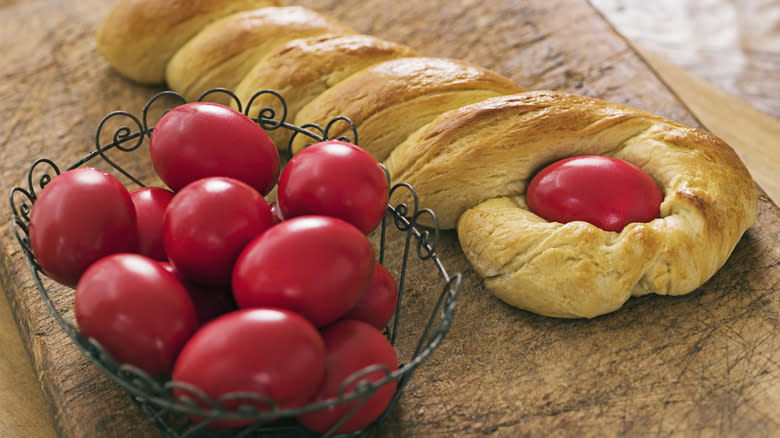
Decorating eggs for Easter is a common practice around the world, and in Greece, red eggs play a traditional role in the holiday proceedings. Once they are dyed, they're baked into a braided Easter loaf called a tsoureki. Its three stands symbolize the Holy Trinity, while the red dye symbolizes the blood of Christ and the egg symbolizes rebirth. In some families, red eggs are the first food consumed after fasting for Lent. They are also the centerpiece of a game called tsougrisma. Each person is given an egg and opponents take turns lightly tapping each other's eggs with the goal of cracking your opponents' eggs without cracking your own. Whoever wins is believed to have good luck for a year.
Red eggs are also an important symbol in Chinese culture where they are used during celebrations for an infant's one-month birthday. The tradition is said to date back many centuries to a time when the mortality rate among newborns was high. As a result, the one-month milestone was treated as its own kind of birthday. As in the Greek tradition, red eggs symbolize birth. Additionally, red egg parties also include ginger marinated in vinegar to help the mother recover from childbirth.
Wine Clarifying
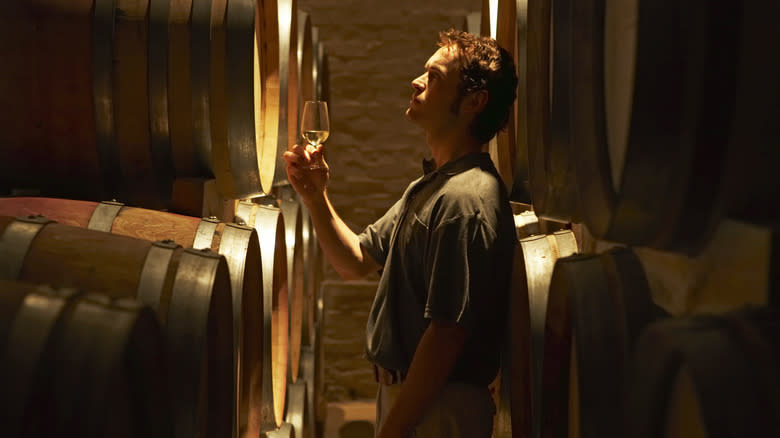
Winemaking is a long, complex process that involves growing and crushing grapes, fermenting the juice, clarifying it to remove unwanted particles, and bottling and aging it. Each step is critical, but clarification is not as widely discussed as the storied terroir of the vineyard or the aging process. And yet, even the most casual wine drinker would notice if the step was skipped. During filtration, so-called fining agents are added to the wine to attract unwanted particles that cause the liquid to be hazy and develop sediment. They also remove astringency, bitterness, and even color. When fining agents are added to the wine, these unwanted particles gather around them, creating a mass that sinks to the bottom and can be easily removed.
There are many popular fining agents, such as gelatin and isinglass (the more palatable word for fish bladders), and egg whites are one of them. In Burgundy, winemakers have been using eggs to remove tannins from their products since ancient times, and many continue to use them. They are prized for their ability to remove bitter tannins without removing color or less harsh tannins. Given their ready availability, egg whites are also a favorite fining agent among amateur winemakers.
Datemaki (Japan)
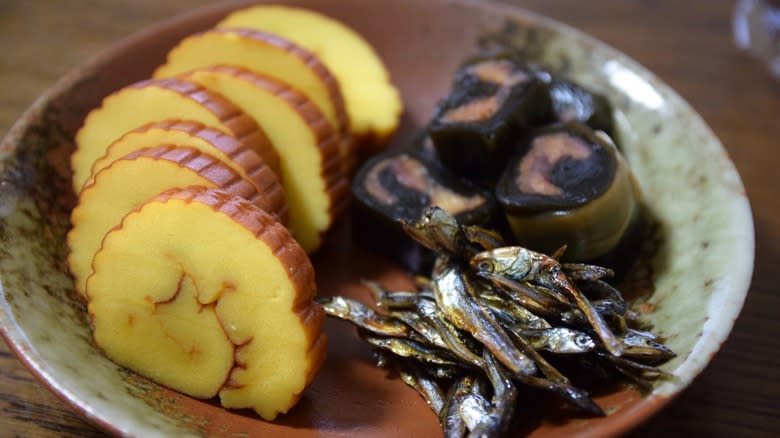
While Japan's spin on custard is savory, its spin on omelets is sometimes sweet. Datemaki is made of a thick layer of egg mixed with squares of fish cake, mirin, sake, sugar, soy sauce, and salt. The mixture is baked until the top has browned. Once it's removed from the oven, it's rolled into a tight cylinder and left for several hours to keep its shape. Then, it's cut into rounds to reveal a delicate spiral.
Datemaki is most commonly served as part of osechi ryori, a special category of food served on New Year's Day in decorated boxes called jubako. The tradition dates back to the 10th century in the Heian Period and is still widely practiced. Other osechi ryori served alongside sweet and savory datemaki are lotus root (renkon), herring roe (kazunoko), candied anchovies (tazukuri), and soba noodles, among many others. Although some of these are difficult to replicate at home, datemaki is relatively straightforward and its ingredients can be found around the U.S. For a smooth texture, strain the mixture before baking it. You can also use the broiler to create a brown layer at the top without overcooking the inside.
Foi Thong (Thailand)
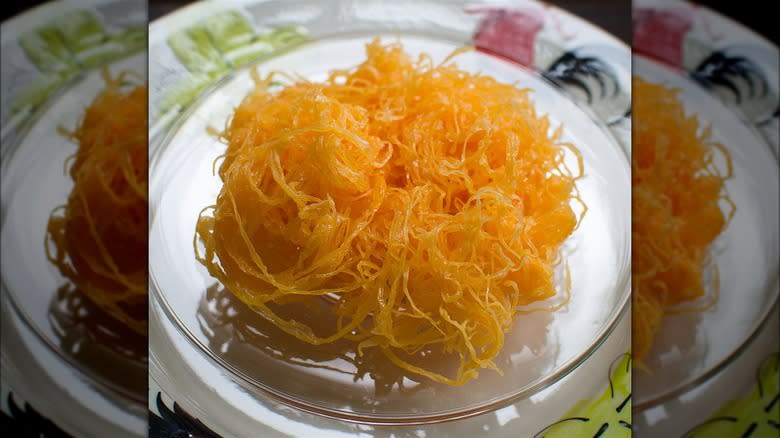
The story of food is often the story of migration and colonialism, and foi thong is the perfect example. In the 16th century, Portugal became the first European country to colonize parts of Southeast Asia, and brought its food preferences with it. These days, many popular desserts in Thailand are made with egg yolks, a common ingredient in many Brazilian desserts as well. This throughline is easily traced to the historical occupation of Portugal, whose cuisine is full of egg yolk desserts.
Foi thong was only lightly adapted from the Portuguese dish fios de ovos (egg threads). Made of long, thin strands of sugar-boiled egg yolk, the dessert looks like golden spaghetti but is easily distinguished once you take a bite. It's made by boiling sugar syrup with fragrant pandan leaves and then squeezing a thin stream of egg yolks into the liquid through a small hole cut into the corner of a plastic bag. Once the yolk strands have cooked, pull them out of the water and serve them immediately. Foi thong is often served at weddings, with the golden color symbolizing prosperity and the length of the strands (one of the few elements that distinguish the dish from the shorter strands of Portuguese fios de ovos) symbolizing eternal love and longevity.
Read the original article on Mashed


